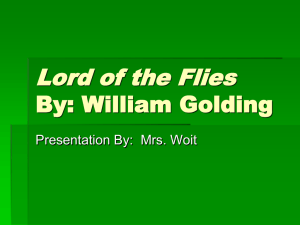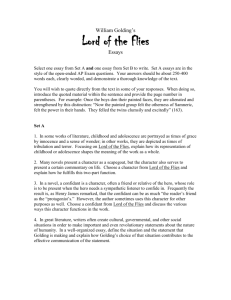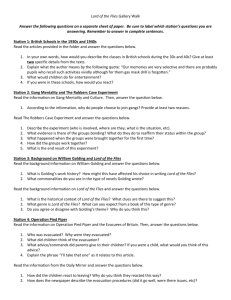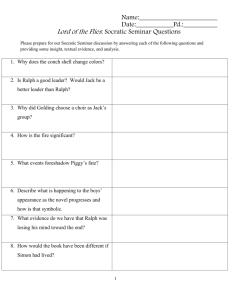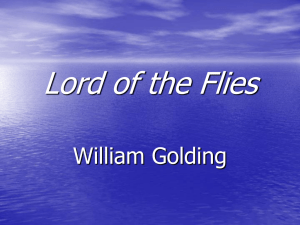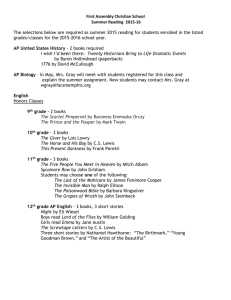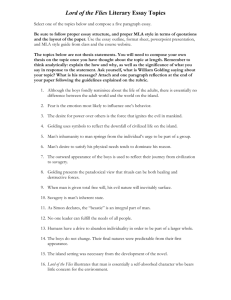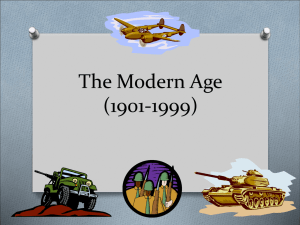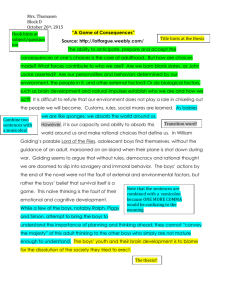Literary Devices in Lord of the Flies
advertisement
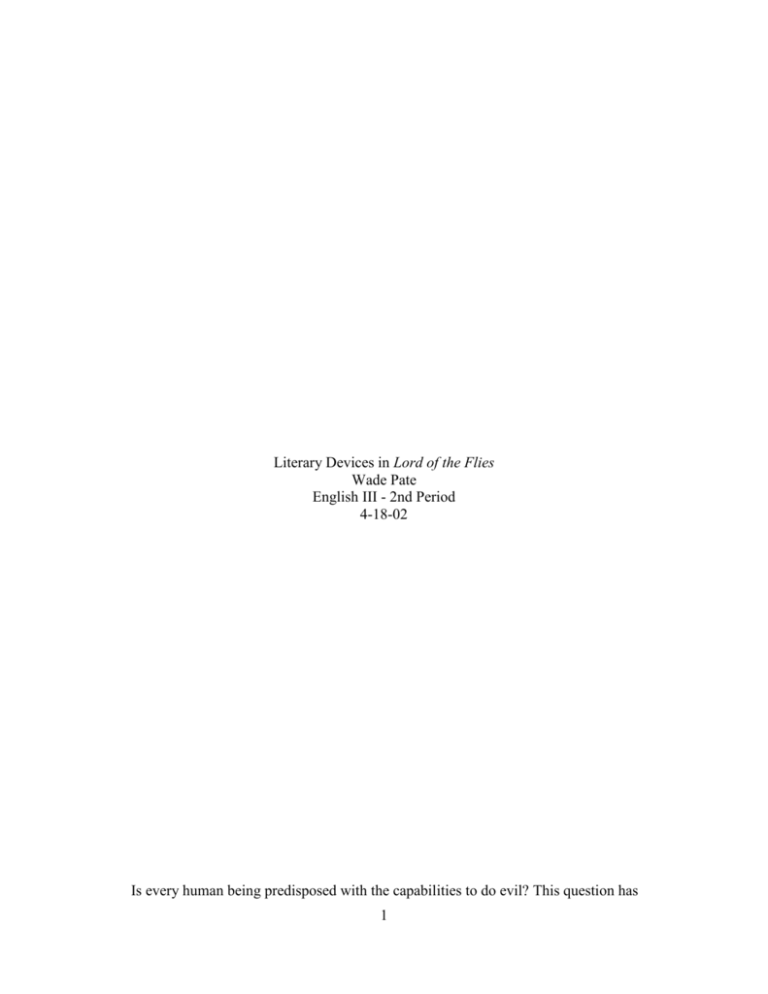
Literary Devices in Lord of the Flies Wade Pate English III - 2nd Period 4-18-02 Is every human being predisposed with the capabilities to do evil? This question has 1 stimulated minds since the beginning of time. In the Bible, as far back as the book of Genesis, we find the ineluctable capacity of man to commit evil. Likewise, in William Golding’s Lord of the Flies we find the depiction of the proclivity of man to transgress. William Golding “presents the universe under the guise of a school adventure story on a coral island” (Forster V). Golding presents the universe and the inescapable struggle of human kind between good and evil through his prolific use of symbols and metaphors. Symbols are one of the principle literary devices used by Golding in Lord of the Flies. Golding uses many of the devices discovered by the boys to represent vital elements of structured society. Ralph makes the statement, “The fire’s the most important thing” (Golding 162). The fire symbolizes the structured society the boys want to exist on the island. The fire represents structure and organization. Without the fire, the boys will never be rescued, and without an organized, structured society, they will not survive. Just as organization and structure are essential to the perpetuation of a society, the fire is vital to the survival of the boys on the island. When describing the setting of the novel, the narrator states, “It [the island] was roughly boat-shaped” (Golding 27). Golding uses this symbolic reference to show that the island symbolizes seclusion. Like a boat, the island needs a cap- tain. The boys are in their own world and Golding creates a sense of urgency for one of the boys to step up and take charge of their “ship.” Golding also uses the conch, an instrument used to call meetings and establish order, as a major symbol of power. Piggy has the conch and tries to use it to voice his opinion but, “the conch doesn’t count on top of the moun- tain” (Golding 43). The immature boys have a faulty sense of structure and organization because they are altering the rules to accommodate their personal needs. This selfishness is one of the defects of their society and human nature. In the case of the boys’ society, their selfishness ultimately led to their society’s destruction. Later on in the novel, a huge rock rolled by some of the other savage-like boys strikes Piggy and “the conch explod[es] into a thousand white fragments and cease[s] to exist” (Golding 209). The conch’s destruction symbolically illustrates the end of the boys’ structured society and 2 the beginning of mass chaos. William Golding uses symbols to portray the complex situation the boys are in on the island and to address the true nature of human kind. Metaphors are also one of the principle literary devices used by Golding in Lord of the Flies. Golding uses metaphorical references to show the many underlying facets and capabilities of the boys and the environment they inhabit on the island. The narrator states, “The creature was a party of boys” (Golding 16). The boys were literally the dark creature groping along in the jungle, and figuratively the group was an evil creature capable of wreaking havoc on the island. This metaphorical statement illustrates the underlying capabilities of the seemingly innocent boys to commit evil. Golding also uses this statement as a means of foreshadowing. The group thought to be an evil creature turns out to be the piv- otal force behind the destruction of the society the boys have established. When describing the surroundings, Golding states, “The sun in the west was a drop of burning gold that slid nearer the sill of the world” (Golding 44). In essence, the horizon is the end of the boys’ world. The boys are alone and the distant horizon is the edge of their solitary confinement. Rather than blandly describing the setting, Golding uses a metaphorical reference that makes the environment and situation of the boys in relation to the island enchanting while still daunting. Golding uses metaphors to add suspense to the novel through the revelation of the underlying characteristics of the characters and setting. William Golding uses symbols and metaphors exquisitely to portray the underlying theme of evil being predestined in every individual. This disclosure illustrates that society has flaws because every human being in society has flaws. Through the diminishing of the foibles of human nature, we can develop a lasting society. Works Cited 3 Forster, E. M. Introduction. Lord of the Flies. By William Golding. New York: Riverhead Books, 1997. Golding, William. Lord of the Flies. New York: Riverhead Books, 1997. 4
